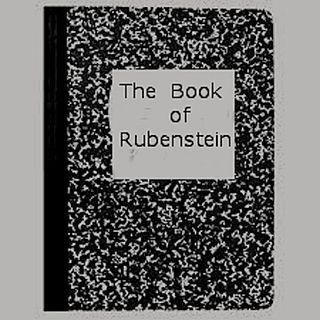Mormons trace their origins to the visions that Joseph Smith reported having in the early 1820s while living in upstate New York. In 1823, Smith said an angel directed him to a buried book written on golden plates containing the religious history of an ancient people. Smith published what he said was a translation of these plates in March 1830 as the Book of Mormon. --Wikipedia

Boasting of more than two-three followers, the well-known contemporary “Church of Rubenstein,” often ridiculed in the media as a superstitious and dangerous cult, has at long last revealed the true story behind its creation myth.
Many have criticized the group from the start, asserting that it made an intractable, tactical error at its inception by failing to secure a suitably charismatic leader to head the organization, choosing instead a fairly lethargic, lackluster, ordinary Jewish guy from the Jersey suburbs who has thus far, over the course of the group’s 20+ year history, managed to accumulate only three legitimate followers, two of which have since passed away, leaving only one living devotee, the leader’s cat, Kugel, a Mexican-Sephardic tabby named after a popular potato dish.

In an effort to stir up a media frenzy and attract new followers to the all-but-defunct Church of Rubenstein, the leader, whose name, inexplicably, is Irving Blumberg, has at last revealed to the public the inspirational source of the religion, an ancient tome that Blumberg presumably unearthed in 1992, in a 7-11 parking lot just outside his childhood home in Metuchen, NJ.
Blumberg’s story at the time was widely publicized in the Metuchen Friar’s Club Weekly Newsletter, in which he reported that after exiting the popular 7-11 franchise where he had purchased a can of Chef Boyardee Spaghetti & Meatballs and a grape Slurpee, he stumbled on the way back to his car and kicked over a piece of loose asphalt, discovering beneath it an innocuous-looking black and white composition book of the sort that is commonly sold for $1.98 in most convenience stores, with no discernible markings on the outside. Naturally curious, the story goes, Blumberg picked up the book and flipped it open, only to discover its pages to be utterly blank.
It was at that moment the founder of the Church of Rubenstein had the epiphany that would launch his religious movement: “THERE ARE NO TEACHINGS, AND I DO NOT TEACH THEM.” People flocked to his enigmatic message, and before long his followers numbered in the tens, and were easily identified by the familiar black and white notebooks they all carried with them everywhere, the contents of which they would reveal to no one, at the risk of excommunication. Only now that the original manuscript has at last been disclosed to the public is there widespread speculation that all of the notebooks carried by followers were likely blank as well.
“Our Scripture says it all,” Blumberg stated in a press conference. “It’s all in there. And if you can’t read between the lines, it’s because there are no lines. That’s the beauty of it.”
So why “Rubenstein”? Where did the name come from? “Simple,” Blumberg replied to reporters, “This goofy guy Rubenstein was one of my best friends growing up, and I wasn’t about to put my name on such a ludicrous movement. I never in a million years imagined it growing into such a huge thing.”
At the time of this writing, journalists were tracking the lone feline devotee, Kugel, in hopes that she would lead them to the elusive Rubenstein, for whom this religious phenomenon of the 20th century was named, but thus far the feline has merely led investigators to a bowl of dry pellets in a ceramic bowl that labs have revealed are composed primarily of “chicken meal, poultry byproducts, and guar gum.”
Thus, for the moment, the true identity and whereabouts of Rubenstein remains a mystery, although lately there has been some speculation about a neighbor who lives two doors down from Blumberg in Metuchen, a man the locals identify simply as “Mr. Rubenstein.” Coincidence? Unlikely.


